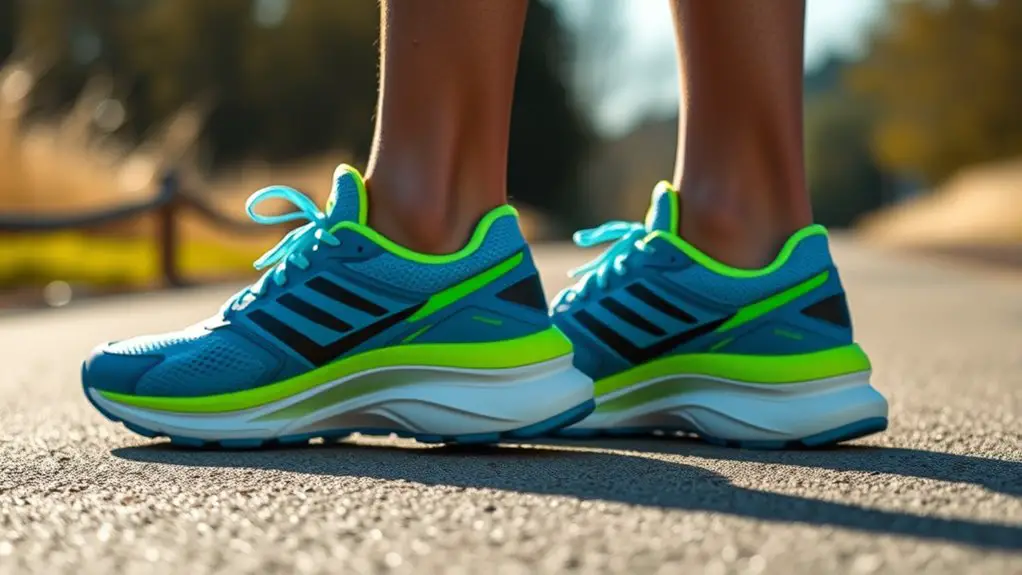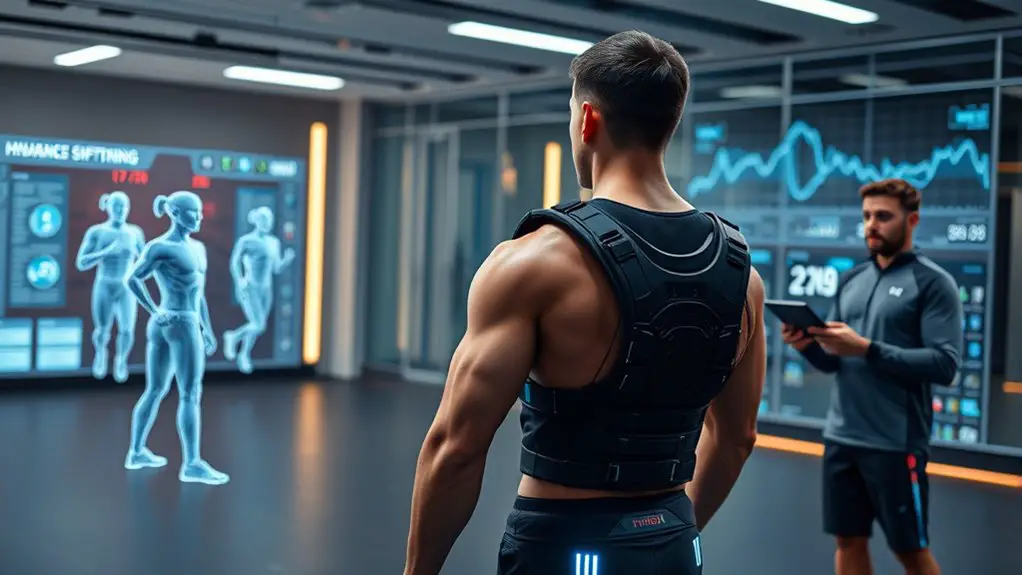The future of wearable fitness tech in sports is promising. You'll see innovations like smart fabrics that monitor your body in real-time and AI-powered insights that personalize training strategies. These devices not only track your performance but also help prevent injuries and promote mental well-being. As comfort and data accuracy improve, expect a shift in how athletes train and compete. Keep exploring to discover more about the exciting advancements on the horizon.
The Rise of Wearable Fitness Technology
As technology continues to evolve, wearable fitness devices have transformed the way athletes and fitness enthusiasts track their performance and health. You're no longer just relying on guesswork; these gadgets give you real-time data, empowering you to push your limits and embrace your potential. Whether it's monitoring your heart rate, tracking your steps, or analyzing your sleep patterns, these devices act as personal coaches on your journey to freedom in fitness.
Imagine having the power to make informed decisions about your workouts, all from a device on your wrist. You can set goals, see your progress, and adjust your training accordingly, ensuring that you're always moving toward your ideal self. The rise of wearable fitness technology isn't just about numbers; it's about liberating you from uncertainty, allowing you to take charge of your health and performance in ways you never thought possible. Additionally, real-time heart rate monitoring is essential for optimizing your workouts and ensuring safety, enabling smarter training decisions.
Key Innovations in Wearable Devices
With innovations rapidly advancing, wearable fitness devices now boast features that go far beyond basic tracking. You'll find heart rate monitors that provide real-time feedback, ensuring you stay in your ideal training zone. GPS capabilities let you explore new trails or routes without fear of getting lost, giving you the freedom to discover while you work out.
Smart fabrics are now embedded with sensors that can monitor everything from muscle fatigue to hydration levels, tailoring your experience to meet your body's unique needs. Additionally, many devices offer seamless integration with your smartphone, allowing you to receive calls and messages without interrupting your flow.
These advancements empower you to take control of your fitness journey, encouraging you to push boundaries and access your potential. Furthermore, AI provides tailored workouts that adapt to your individual strengths and goals, enhancing your training experience. With each stride, you're not just tracking progress; you're embracing a lifestyle that celebrates movement, exploration, and personal growth.
Data Analytics and Performance Optimization
While you wear your fitness tracker, it collects a wealth of data that can greatly enhance your performance. This data isn't just numbers; it's a roadmap to revealing your potential. By analyzing metrics like heart rate, pace, and recovery time, you can pinpoint your strengths and weaknesses, tailoring your training to elevate your game.
Imagine knowing exactly when to push harder or when to take a step back—this insight gives you the freedom to train smarter, not just harder. With real-time feedback, you're empowered to make adjustments on the fly, maximizing every workout.
As you embrace this technology, you're not just following a generic routine; you're crafting a personalized approach that aligns with your goals. The fusion of data analytics and performance optimization transforms your fitness journey, allowing you to break barriers and achieve new heights in your athletic pursuits. Your freedom to excel is just a data point away. Moreover, integrating recovery technology into your routine can further enhance your overall performance and well-being.
Health Monitoring and Injury Prevention
When you wear a fitness tracker, it doesn't just help you optimize performance; it also plays an important role in health monitoring and injury prevention. By keeping tabs on key metrics, you can stay in tune with your body and protect yourself from potential setbacks.
- Heart Rate Monitoring: Track your heart rate during workouts to avoid overexertion and guarantee you're training in the right zone.
- Sleep Patterns: Quality sleep is vital for recovery. Monitoring your sleep can help you identify patterns that impact your performance.
- Movement Analysis: Some devices assess your form and biomechanics, alerting you to movements that could lead to injury. Staying properly hydrated is equally important, as it supports overall performance and recovery.
The Role of AI in Personalizing Training
Artificial intelligence is revolutionizing how athletes approach their training regimens. With AI, you can tailor your workouts to fit your unique needs and goals, giving you the freedom to train smarter. By analyzing your performance data, AI can identify your strengths and weaknesses, adjusting your training plan in real-time. This means you're not just following a one-size-fits-all program; you're engaging in a personalized experience that evolves as you do.
Imagine having a virtual coach that learns from every rep, every sprint, and adapts to push you further. You can focus on improving specific areas, whether it's endurance, strength, or agility. Plus, AI can offer insights about recovery, helping you avoid burnout and stay on track. This personalized approach empowers you to take control of your training, ensuring that you get the most out of every session and enjoy the journey toward your athletic goals. Furthermore, utilizing mindfulness in athletic performance can further enhance your focus and engagement during workouts.
Future Trends in Wearable Fitness Tech
As personalized training becomes more sophisticated with AI, the future of wearable fitness tech is set to evolve dramatically. You'll likely see innovations that not only enhance your workouts but also promote your overall well-being. Here are some trends you can expect:
- Smart fabrics: Clothing embedded with sensors that monitor your heart rate, muscle activity, and hydration levels in real-time.
- Biometric data integration: Wearables that analyze your unique physiological data to provide tailored insights and recovery strategies.
- Augmented reality interfaces: Devices that overlay digital information on your surroundings, making workouts more interactive and engaging.
These advancements will empower you to take control of your fitness journey like never before. With the freedom to customize your training based on real-time feedback, you'll be able to push boundaries and achieve your personal best. Embrace the future; it's all about enhancing your experience and maximizing your potential.
Integration With Other Technologies
While the evolution of wearable fitness tech is exciting, its true potential is realized through seamless integration with other technologies. Imagine wearing a fitness tracker that syncs effortlessly with your smartphone, providing real-time data on your performance while you're out in nature. You could adjust your workout based on insights from your heart rate, sleep patterns, and even nutrition apps, all in one cohesive experience.
This interconnectedness doesn't just enhance your personal fitness journey; it allows for smarter training regimens. By integrating with coaching platforms and social media, you can share accomplishments or receive motivation from friends. Plus, advancements in AI can tailor suggestions specifically for you, making your fitness goals more achievable. Real-time analytics empowers coaches and athletes to make data-driven decisions that elevate performance.
Ultimately, the freedom you gain from this tech synergy lets you focus on what matters most: your passion for sports and personal growth, while the tech handles the details.
Challenges and Limitations of Wearable Devices
Despite the impressive advancements in wearable fitness technology, several challenges and limitations still impact their effectiveness. You might find that while these devices offer valuable insights, they aren't without issues that can hinder your performance and experience. Here are a few key concerns:
Despite advancements in fitness tech, challenges like data accuracy and comfort still affect their effectiveness and your experience.
- Data Accuracy: The metrics provided can sometimes be inconsistent, leading to misleading conclusions about your fitness level.
- Battery Life: Frequent charging can be a hassle, especially during intensive training periods when you need your device most.
- Comfort and Wearability: Some devices can feel bulky or uncomfortable, which can distract you during workouts.
Additionally, the effects of sleep deprivation on athletic performance can further complicate how accurately these devices assess your recovery and readiness. Navigating these challenges is essential for maximizing the benefits of wearable tech. By understanding the limitations, you can make informed choices about which devices best suit your needs, allowing you to enjoy your fitness journey with greater freedom and effectiveness.
The Impact on Athlete Mental Health
Wearable fitness tech can greatly influence athlete mental health, offering both benefits and challenges. On one hand, these devices can help you track your progress, providing a sense of achievement and motivation. When you see your hard work reflected in data, it can boost your confidence and encourage a positive mindset. Plus, real-time feedback allows you to make adjustments, preventing injuries and reducing anxiety about performance.
However, there's a flip side. Constant monitoring can lead to overemphasis on metrics, causing stress and burnout. You might feel pressured to meet certain targets, which can weigh heavily on your mental well-being. The comparison game can also creep in, making you question your worth against others. Incorporating mindfulness practices can help athletes navigate these pressures while maintaining their mental clarity.
Ultimately, it's about finding a balance. Embrace the insights these tools offer while staying mindful of your mental health. Freedom in sports comes from knowing your limits and prioritizing your well-being above all else.
The Evolution of Sports Coaching With Wearables
The insights gained from wearable fitness tech not only benefit athletes but also greatly enhance sports coaching. With real-time data at your fingertips, you can tailor training sessions to individual needs, optimizing performance while respecting each athlete's unique journey. This tech empowers you to make informed decisions and foster a more dynamic coaching environment.
- You can analyze metrics like heart rate, sleep quality, and recovery times.
- Instant feedback allows for immediate adjustments during practice, enhancing skill development.
- Data-driven strategies lead to more effective game plans, keeping your team one step ahead. Additionally, the integration of functional strength training principles helps coaches design exercises that improve overall athletic performance.
Frequently Asked Questions
What Are the Costs Associated With Wearable Fitness Tech for Athletes?
When considering wearable fitness tech, you'll find costs vary widely. Devices can range from affordable basics to high-end models, plus subscriptions for tracking services. It's crucial to weigh benefits against expenses for your needs.
How Do Wearables Affect the Relationship Between Athletes and Coaches?
Picture your training sessions, data flowing like a river. Wearables deepen your bond with coaches, providing insights that spark conversations. You're not just numbers; you're a team, forging a path to success together.
What Privacy Concerns Exist With Wearable Fitness Technology?
When using wearable fitness tech, you might worry about data privacy. Your personal health information can be tracked and shared, potentially exposing you to unwanted scrutiny or misuse. It's essential to understand these risks before diving in.
Can Wearable Devices Replace Traditional Training Methods Entirely?
Did you know 60% of athletes believe wearable devices enhance performance? While they offer valuable insights, they can't fully replace traditional training methods, as personal connection and experience remain essential for achieving true athletic potential.
How Accessible Is Wearable Fitness Technology for Amateur Athletes?
Wearable fitness technology's becoming increasingly accessible for you as an amateur athlete. With affordable options and user-friendly interfaces, you can track your progress, enhance performance, and enjoy your training without breaking the bank.




